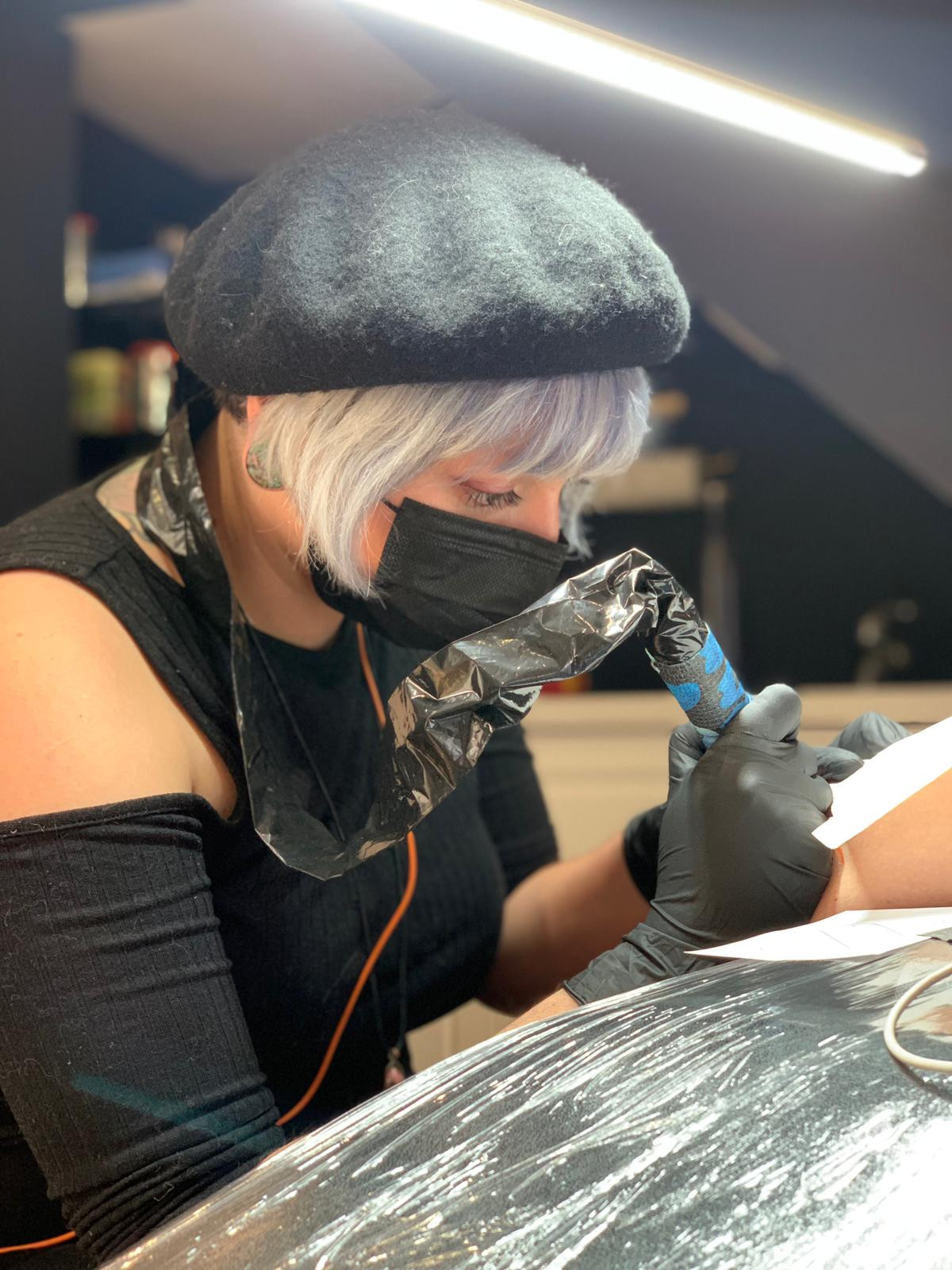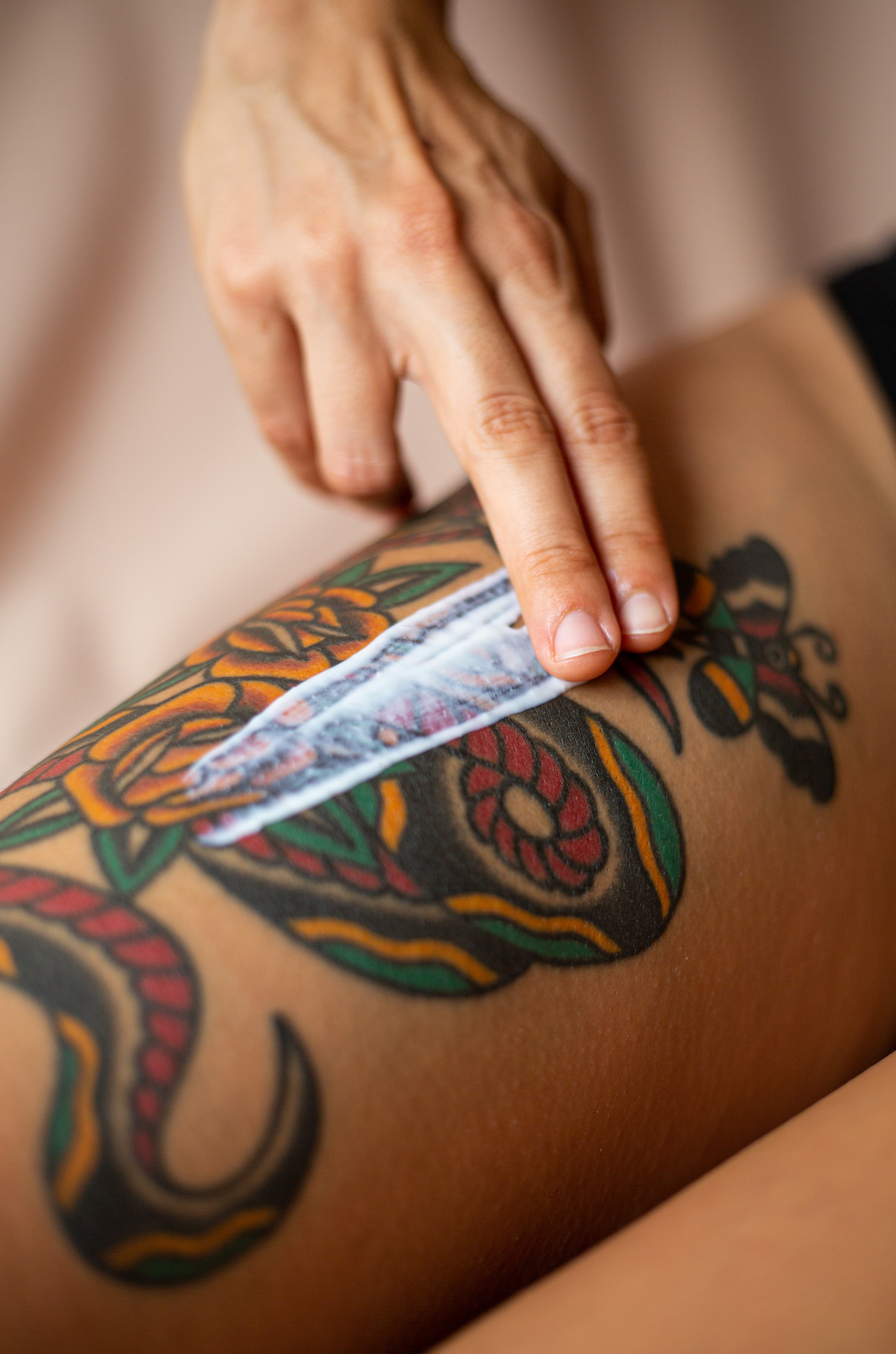How Do Tattoos Age? At tattooat.com, we dive deep into the art and science of tattooing, offering insights into how tattoos change over time and what steps you can take to keep them looking their best. Discover the factors influencing tattoo longevity, from ink types to aftercare routines, ensuring your body art remains vibrant for years to come. Explore our curated collection of tattoo designs, find skilled artists, and access expert advice to preserve your tattoo’s beauty.
1. Understanding the Tattooing Process and Its Impact on Skin
What exactly happens when a tattoo needle meets your skin?
From a microscopic viewpoint, when needles puncture the skin, it triggers a localized inflammatory response. This involves tissue swelling and the rupture of superficial capillaries in the skin’s dermis, leading to minor bleeding. As the skin heals, the perforations caused by the needles are sealed with plugs of exudate. In the weeks that follow, the superficial layers of the epidermis gradually peel away, shedding any pigment that remains “too high” in the epidermis. Consequently, only the tattoo pigments that settle in the dermis contribute to the tattoo’s final appearance, creating a “matte” effect once the epidermis has regenerated. This ensures the tattoo’s lasting presence. Macrophages, cells responsible for engulfing pigments, progressively phagocytose the pigments, and these cells migrate to the local drainage nodes. Any remaining pigment is primarily found in fibroblasts and macrophages that have not migrated. Additionally, some pigments can reside in the connective tissue within the dermis, nestled between collagen bundles.
Over a lifetime, a tattoo’s histological state is not static. Macrophagic activation occurs alongside subtle inflammatory changes, including mild fibrosis of the papillary dermis, capillary proliferation, and nonspecific lymphocytic infiltration.
 Close-up view of tattooing process, highlighting the needle and ink interaction with the skin layers
Close-up view of tattooing process, highlighting the needle and ink interaction with the skin layers
2. How Does Skin Aging Affect Tattoos?
Why do tattoos fade as you age?
Skin aging is influenced by multiple factors. Chronological aging is inevitable, although genetic diversity means not everyone shows the same aging signs at the same age. Hormones, particularly during menopause for women, also play a role. Sun aging affects exposed areas like the face, neck, and hands, varying by location and skin fairness. Smoking also contributes to skin aging.
Normal skin aging includes loss of skin elasticity, increased paleness, dryness, fragility (leading to easy bruising and skin tears), irregular pigmentation, and hair loss.
Tattoos inevitably fade because of light-induced decomposition or pigment transportation via the lymphatic system. Pigment migration by macrophages can blur tattoo lines.
The fading or bleaching of tattoo colors is similar to how colors fade on textiles or book covers after sun exposure. However, because of the high color strength of azo pigments, changes in tattoo color concentration are often overlooked.
3. The Critical Role of Collagen in Tattoo Aging
What role does collagen play in how your tattoo ages?
During skin aging, the dermis loses density and thins, reducing collagen and elastic fibers, as well as glycosaminoglycans, especially hyaluronic acid. This results in decreased viscoelasticity of the dermis.
4. Major Risk Factors Accelerating Tattoo Aging
What factors can speed up the aging process of your tattoo?
Excessive sun exposure immediately after getting tattooed or chronic, repetitive, unprotected sun exposure during the tattoo’s lifetime are major risk factors. According to research from Portland State University’s Art Department, in July 2025, exposure to UV rays causes the ink particles to break down, leading to fading and blurring.
 An example of a tattoo that has aged prematurely due to sun exposure
An example of a tattoo that has aged prematurely due to sun exposure
5. Practical Steps to Minimize Tattoo Aging
How can you keep your tattoo looking fresh for longer?
- Choose a Professional Tattoo Artist: Inexperienced tattooists may deposit pigments sparsely, causing faster fading.
- Avoid Small/Micro Tattoos: Intricate details blur over time.
- Select Low-Risk Areas: Avoid areas prone to rapid aging, such as the face, hands, neck, and elbows.
- Follow Aftercare Procedures: Protect the tattoo from the sun with clothing or sunscreen.
6. The Impact of Color, Ink Type, and Placement on Tattoo Longevity
How do different factors influence how well a tattoo holds up?
Lighter colors, especially white, tend to fade faster. Tattoo artists often use white only for small details because of this. Small tattoos or details and “watercolor” tattoos also age poorly.
Areas constantly exposed to the sun, like the face, fingers, palms, and hands, age more quickly, as do areas subject to frequent trauma, such as elbows and the neck.
7. Can Tattoo Fading Be Reversed?
Is there anything you can do once a tattoo starts to fade?
Unfortunately, fading is irreversible. The only options are to get a new tattoo or cover-up or to undergo laser tattoo removal to eliminate it entirely.
8. The Number One Tip for Preventing Tattoo Fading
What’s the most important thing you can do to keep your tattoo looking new?
There is no single tip, as tattoo aging is multifactorial. However, choosing a skilled tattoo artist, following aftercare instructions, and protecting your tattoo from the sun are essential steps.
9. Long-Term Expectations for Tattoos
Will your tattoos still look good at 60?
It depends on when you got them and how your skin has aged. Tattoos acquired at 59 will likely look good longer than those acquired at 18. Ultimately, you have to accept how they change over time.
 Example of different tattoos, highlighting the variety of styles and color
Example of different tattoos, highlighting the variety of styles and color
10. Expert Insights from Dr. Nicolas Kluger
What are some key insights from a dermatology expert on tattoo aging?
Dr. Nicolas Kluger (@the_tattooed_derm), a dermatologist and professor at Helsinki University Hospital, specializes in skin diseases and researches how tattoos affect the skin. He emphasizes that understanding the tattooing process, protecting tattoos from sun exposure, and choosing a skilled artist are crucial for minimizing aging.
FAQ: Common Questions About Tattoo Aging
1. What exactly happens to tattoo ink under the skin over time?
Over time, tattoo ink particles break down due to sun exposure and are transported via the lymphatic system, leading to fading and blurring.
2. Does the location of a tattoo affect how quickly it ages?
Yes, areas exposed to frequent sun or trauma, such as the face, hands, elbows, and neck, age more quickly.
3. How does sun exposure specifically affect tattoos?
UV radiation breaks down the ink particles, causing the tattoo to fade and lose vibrancy.
4. Are there specific tattoo styles that hold up better over time?
Simpler designs with bold lines tend to age better than intricate, small-detail tattoos or watercolor styles.
5. What aftercare practices are most effective for preventing tattoo fading?
Protecting the tattoo from the sun with clothing or sunscreen and following the tattoo artist’s aftercare instructions are essential.
6. Can moisturizing the tattoo help prevent it from aging?
Yes, keeping the skin moisturized helps maintain its elasticity and reduces the appearance of aging.
7. Do certain skin types affect how a tattoo ages?
Yes, drier skin may cause a tattoo to fade faster than well-hydrated skin.
8. Is there a way to refresh an old tattoo?
Yes, a tattoo artist can touch up the tattoo to refresh the lines and colors.
9. What should I look for in a sunscreen to protect my tattoo?
Choose a broad-spectrum sunscreen with an SPF of 30 or higher to protect against UVA and UVB rays.
10. How often should I reapply sunscreen on my tattoo when exposed to the sun?
Reapply sunscreen every two hours, especially after swimming or sweating.
The Ultimate Guide to Tattoo Longevity
| Factor | Impact | Prevention/Solution |
|---|---|---|
| Sun Exposure | Breaks down ink particles, causing fading and blurring. | Use sunscreen, wear protective clothing. |
| Skin Aging | Loss of elasticity and collagen leads to distortion. | Stay hydrated, moisturize regularly. |
| Tattoo Placement | Areas with high friction or sun exposure fade faster. | Choose less exposed areas. |
| Ink Quality | Poor quality ink fades quickly. | Choose a reputable artist using high-quality inks. |
| Aftercare | Improper care leads to infection and ink loss. | Follow artist’s instructions carefully. |
| Lifestyle (Smoking) | Accelerates skin aging. | Avoid smoking. |
| Ink Color | Lighter colors fade faster. | Opt for darker, more durable colors. |
| Tattoo Size/Detail | Small details blur over time. | Choose bolder designs with fewer fine lines. |
| Artist Skill | Inconsistent ink depth leads to uneven fading. | Select an experienced artist. |
| Health Conditions | Certain medical conditions can affect skin health. | Maintain overall health. |
| Factor | Details | Impact on Tattoo Aging |
| Skin Hydration | Maintaining skin moisture levels | Well-hydrated skin retains ink better and ages more gracefully. |
| Diet & Nutrition | Consuming a balanced diet rich in antioxidants | Nutrients support skin health and protect against damage. |
| Genetics | Inherited traits affecting skin elasticity and aging | Genetic factors can influence how well the skin holds the tattoo over time. |
| Profession | Occupations with frequent sun exposure or physical stress | Increased exposure to environmental factors accelerates tattoo aging. |
| Hormonal Changes | Fluctuations during pregnancy or menopause | Hormonal shifts can affect skin elasticity and ink retention. |
| Climate | Living in extreme weather conditions (hot, cold, dry) | Harsh climates can dry out the skin and accelerate tattoo fading. |
| Medications | Certain drugs affecting skin sensitivity or healing | Some medications can increase the risk of tattoo damage and fading. |
| Tanning Habits | Regular use of tanning beds | Artificial UV radiation damages skin and fades tattoos more rapidly. |
| Exfoliation | Frequency and method of skin exfoliation | Over-exfoliating can remove ink particles, while gentle exfoliation promotes skin health. |
| Clothing | Tight or abrasive clothing rubbing against the tattoo | Constant friction can cause ink to fade or blur. |
Discover More at Tattooat.com
Ready to explore endless tattoo design possibilities, find the perfect artist, and learn everything you need to know about tattoo care? Visit tattooat.com today and dive into the world of tattoos with confidence. Whether you’re seeking inspiration, expert advice, or the latest trends, we’ve got you covered.
Address: 1825 SW Broadway, Portland, OR 97201, United States
Phone: +1 (503) 725-3000
Website: tattooat.com
